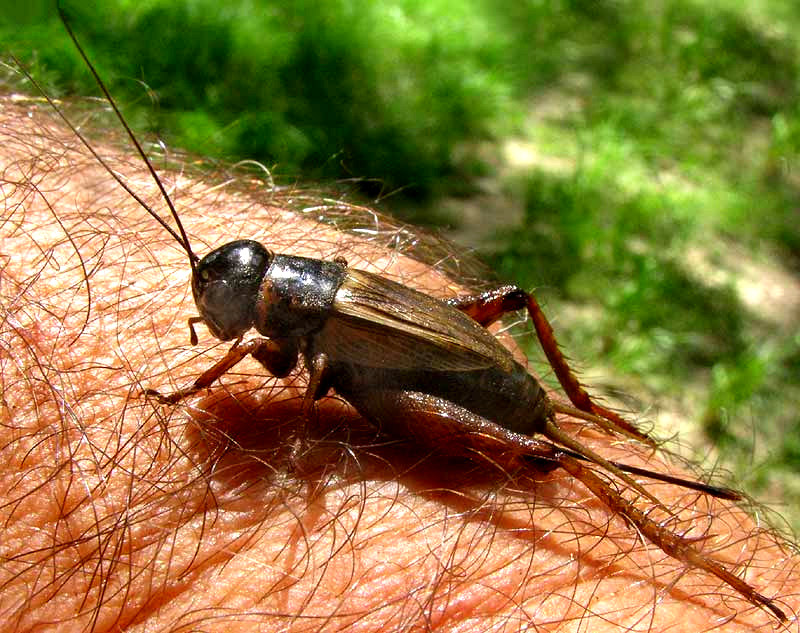Excerpts from Jim Conrad's
Naturalist Newsletter

from the August 12, 2012 Newsletter issued from the woods of the Loess Hill Region a few miles east of Natchez, Mississippi, USA
FIELD CRICKET
Before long night sounds will grow even more thunderous than they are now and among the lustiest night-singers will be the crickets. The other day when a cricket turned up floating in the dogs' water trough I felt sorry for the struggling cricket but glad to have a chance to take a good look at her. I knew she was a female because of the swordlike ovipositor projecting from her rear end. Ovipositors enable females to insert eggs below the ground, into cracks, etc. You can see our dog-water cricket rescued and drying out on my hairy arm above.
Calling something a cricket isn't being very precise. On the evolutionary Tree of Life if you look at a certain group of branches and twigs you see that there's a gradual transition between grasshoppers and crickets. Whole taxonomic families and subfamilies of crickets exist harboring numerous genera and dozens or hundreds of species. Among the various species-rich groups of kinds of crickets are camel crickets, sand crickets, mole crickets, bush crickets, tree crickets, ground crickets, field and house crickets...
Happily, on the Internet the University of Florida provides a nicely illustrated, easy to use online "Key to Families and Subfamilies of Crickets."
There, mostly on the basis of the general shape and size, and the kind of spines on the tibia of our cricket's back leg I could confirm that our dog-water cricket was a member of the Field Cricket Subfamily, the Gryllinae. A page linked to from the key further helped me -- on the basis of comparing pictures -- that our cricket was a member of the genus Gryllus, the field cricket genus.
Currently a good guess is that in the US we have maybe over 30 recognized or soon-to-be-recognized field cricket species of the genus Gryllus, and for the most part they are all so morphologically similar that they are best distinguished by their songs and life histories.
So, I can't say which species of field cricket we have here. However, the most commonly listed one for our area and one supposed to be appearing about now is the Fall Field Cricket, GRYLLUS PENNSYLVANICUS, so that's what we'll call it here. Maybe a later field worker trying to figure out who we really have will be glad to see what a field cricket looks like that's been found in dog water in August in southwestern Mississippi.
By the way, notice that not only does our cricket bear the long, slender, swordlike ovipositor projecting backwards from the tip of her abdomen, but also there are two brown, antenna-like bristles on both sides of the ovipositor. Those are cerci (singular cercus). An online 2010 article by Mulder et al in the Journal of Neurophysiology finds that cricket cerci function as "a low-frequency, near-field extension of the animal's auditory system and encodes information about the direction and dynamic properties of low-velocity air currents with great accuracy and precision." In other words, cerci help crickets "hear" and locate very low sound frequencies and slight movements of air such as those an approaching predator might generate.